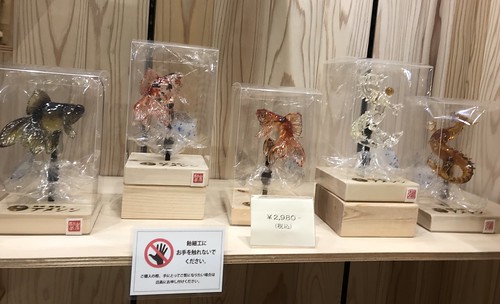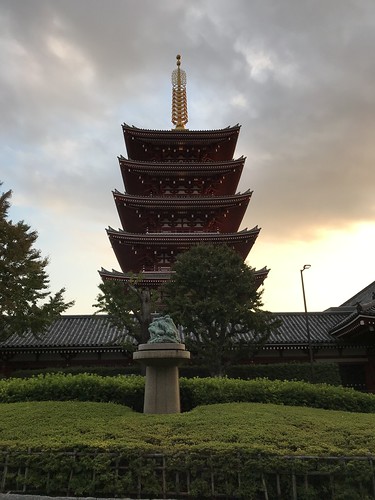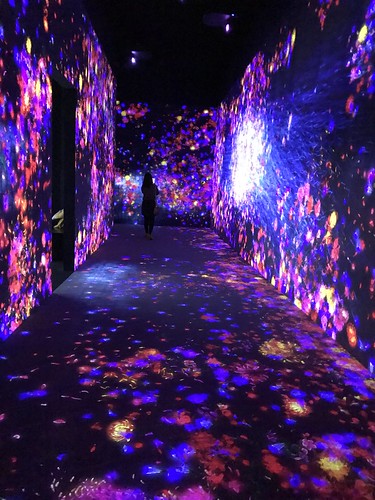History Comes Alive in Tokyo
To get acquainted with Tokyo’s history, with which I am unfamiliar, I started my journey at the city’s history museum, the Edo-Tokyo Museum. From the early 17th century until the mid 19th century, the Tokugawa shogunate ruled Japan from this city. By touring the permanent exhibit filled with artifacts and replicas, we learned about the 400 years of history from the Edo period to the present.

Edo-Tokyo Museum
To enter into the Edo Zone, visitors cross over a replica of the Nihonbashi Bridge. On the other side, we briefly viewed a model depicting the area north of the bridge in the Early Edo period. The Tokugawa family produced 15 generations of heirs to the shogun. Hollyhock crests were used exclusively by this family throughout the Edo Era.

Replica of Nihonbashi Bridge at Museum
Considering life in the 17th century, it was not surprising to see the disparity between different groups. Edo Castle was situated in the middle of the city. The chonin (townspeople) were relegated to more densely populated areas while the daimyo (feudal lords) had considerably more space. Additional exhibits offered glimpses into everyday life, including clothing, entertainment and art, the importance of printing, and the expansion of the city due to increased trading opportunities.

War Hat worn by 15th shogun Tokugawa Yoshinobu with hollyhock Crests on black lacquer
We paused at artifacts depicting the shogun’s warrior lifestyle and literary culture. Long before a library system was developed, book-lenders charged a fee to people who wanted to read used or new books. Books were created by using either plate-making prints using woodblocks or movable types made of wood or copper.

Helmet and armor for Matsudaira Family of Saijo made during mid Edo Period
More than a decade after Commodore Matthew Perry’s ships came to Japan, the Edo shogunate was abolished, and an imperial regime was instituted. During the transition from Edo to Tokyo, western ideas and practices were slowly adapted and industrialization eventually occurred. The process of change was slow as people had to accept a new social order. World War I made the Japanese more aware of the outside world. In succeeding decades, the emphasis was placed on creating buildings that could withstand earthquakes, fires, and floods.
Exhibits focusing on World War II and the post-war era leaned heavily toward the effects of the allied bombings and the limitations and hardships created during the post-war occupation. While the bombings were intense, the construction of the homes, high winds, and a prohibition against evacuating without permission created more casualties. In the aftermath of the war, the people depended on the black markets to survive. This is contrasted with the economic growth starting in the 1950s. Additional displays show the changes from that time to the present.

Modernization exhibit
Amezaiku Experience. Traditional Candy Making
For a change of pace, we decided to participate in an Amezaiku workshop where we learned the traditional art of candy sculpting dating back to the eighth century. This custom was popular during the Edo period when people would watch artisans create different objects in public forums. Nowadays, artisans produce an assortment of animals and characters for specialty shops.

Amezaiku for Sale at Workshop
At the workshop, we watched live and video demonstrations in Japanese before we attempted to make our personal rabbit creations. The presentation was translated by our guide, and the video had subtitles.
The ingredients were heated in a pot to 90 degrees Celsius. After a small ball of soft candy was removed and placed on a short stick, we had approximately three minutes to form a rabbit. Due to the consistency of the candy, mistakes cannot be fixed.

Sandy attempting to make a Japanese Candy Rabbit
While the demonstrator had no problem touching the slightly cooled candy, I found it very hot to the touch as I tried to manipulate places that I had incorrectly cut with a unique scissor. Laughter abounded as our private guide, Ms. Makino, Ira, and I decided to follow our instructor’s instructions. Even though our end product barely resembled the professional samples, we had a hilarious and fun time attempting to make candy rabbits.
Sensoji Temple
To reach the Sensoji Temple in Asakusa, we walked through the Nitenmon Gate (the Gate of Two Deities) dating back to the 17th century. An adjacent sign stated, “used when the Tokugawa Shogun visited the shrine.” The temple was completed in the seventh century and is recognized as Japan’s oldest Buddhist temple, even though it was rebuilt after World War II bombings.
A map identified the location of numerous buildings. A plethora of visitors and worshippers scurrying from one building to the next made it challenging to capture good pictures. The easiest to photograph was the five-storied pagoda standing over 50 meters high. As we followed Ms. Makino to the Main Hall, we continually inhaled puffs of smoke emanating from oversized incense burners. At times, we struggled to weave our way around masses of worshippers.

5 Story Pagoda
Ms. Makino demonstrated the ritual for purifying one’s hands and mouth at a rectangular waist-high tub with running water and ladles. A few steps away, we stood in front of an array of colorful wooden plaques. She translated some of the prayers left behind by worshippers. Another kiosk offered the opportunity for people to make a donation in exchange for a written fortune. Good fortunes were to be taken home while bad ones were to be tied to a nearby rack.

Ms. Makino demonstrating purification ritual

Prayers left at temple
We stopped to touch a cord hanging from an oversized pair of traditional straw sandals made by 800 residents of Murayama City. A sign advised us that the shoes would ward off evil.
Fortunately, all of the buildings, statues, gates, and small monuments had signs translated into English. Far too often, we have visited foreign countries where we had no clue what we were looking at.
We exited through the red, gold, and green colored Hozomon Gate that was previously used as a storage for treasures for the temple. This led to an area called Nakamise-Dori Street, a shopping street dating back several centuries. Souvenirs, crafts, and street vendors selling sweet and savory snacks were ubiquitous. After meandering through this area, we exited through the Kaminarimon Gate or Thunder Gate.
Rickshaw
We hopped onto a foot-powered rickshaw offered by Ebisuya. After a full day of touring, it was great to be off our feet. For 30 minutes, we relaxed as our U.S college-educated, athletic guide pulled us through the streets of Tokyo.

Two Rickshaw Runners pose with us
Surprisingly, our guide’s pace was steady and quick as he maneuvered through the busy streets. At dusk, we could appreciate the city differently as the street and building lights began to glow on previously viewed landmarks. Our rickshaw guide stopped at various points along the route to take memorable photos.

Rickshaw ride view of Skytree
Modernity at Mori Digital Art
On another day in Tokyo, rain forced us indoors to explore this incredible museum. Technically, this stop does not fall under the category of history. But the outstanding quality of this multi-hour experience caused me to make an exception.
The digital artwork overpowered us as we wandered from room to room in an impressive 10,000 square meter space filled with colorful lights and musical tones. Our imaginations were put in hyperdrive as we embraced our surroundings. Sometimes the digital images permeated into the next area, and other times the next room was unrelated. Even though signs identified each room, I preferred to see the museum as an immersive experience without any boundaries.

Inside Mori Digital Art Museum
Lines formed at some entryways. In the Floating Nest, we relaxed on suspended netting during our allotted time in the enclosed space. Children and adults pranced up a flight of stairs to the Athletic Forest—Future Park, where interactive activities captured the attention of everyone. If we had been accompanied by children, our time in this area would have doubled.

Mori Digital Art Athletic Forest
Our brief stay in Tokyo was complemented by two additional weeks circling Japan on a cruise ship. We stopped at seven Japanese ports of call and Busan, South Korea. My upcoming stories will share historical highlights from our immersive Japanese cruise aboard the Celebrity Millennium.
Sandy Bornstein, the History Comes Alive Through Travel Editor for Wandering Educators, has visited more than 40 countries and lived as an international teacher in Bangalore, India. Sandy’s award-winning book, May This Be the Best Year of Your Life, is a resource for people contemplating an expat lifestyle and living outside their comfort zone. Sandy writes about Jewish culture and history, historical sites, family, intergenerational, and active midlife adventures highlighting land and water experiences.
All photos courtesy and copyright Sandy Bornstein
Disclosure: While in Tokyo, Sandy and Ira were hosted by the Tobu Railway Co, Ltd. They were provided a complimentary stay at the Tobu Hotel Levant Tokyo, a private full-day tour, a traditional lunch, and admission to all attractions.



















